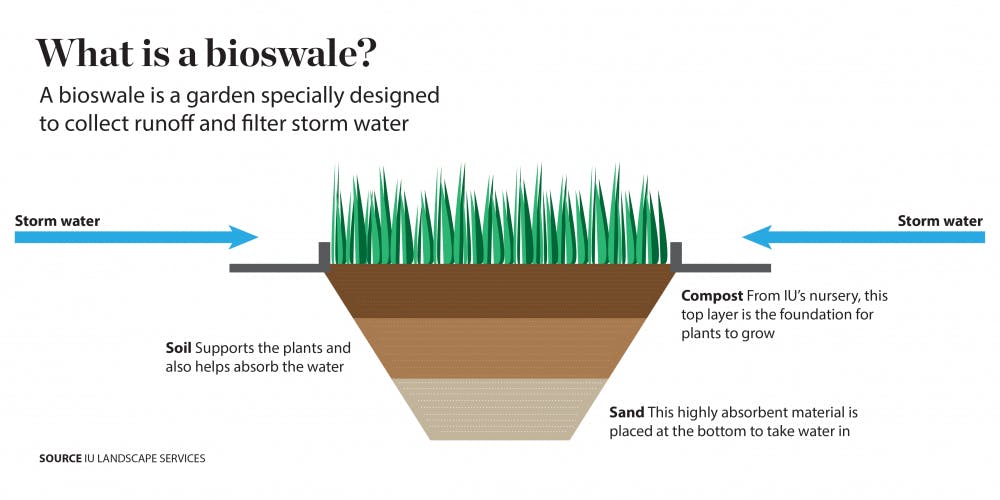Volunteers crouched in the shade of the bushes on the outskirts of the Indiana Memorial Union pay lot #2. With specks of dirt on their hands, each used a trowel to dig small, circular holes in the dark, wet soil.
The volunteers planted fox sedge, beardtongue or purple coneflowers in each small crater they made.
Around 10 volunteers and two employees from IU Landscape Services gathered at the parking lot behind the IMU Thursday afternoon to help install a bioswale. The development is designed to naturally absorb storm runoff in flood areas as an alternative to storm drains.
The project was spearheaded by Elizabeth O’Brien, a graduate student in the School of Public and Environmental Affairs.
O’Brien said she is a part of the Rain-Initiative, which took on the project. The group of graduate students help the University attain sustainability goals through storm water management.
Mike Girvin, the manager of Landscape Services, said that the topography of the campus makes IU prone to flooding. The bioswale will slow down storm water to prevent that from happening in the IMU pay lot #2.
“I don't want to create a lake here,” Girvin said. “Plus, good plants like this will also help capture a lot of the contaminants that would typically come off vehicles in the parking lot rather than putting them into the watershed.”
Before students started planting today, Girvin said landscaping had to dig out the soil two feet deep. Then they created a mix of soil that was one-third compost from the IU Nursery, one-third soil and one-third sand.
Girvin said that installation of the bioswale would take longer than just one day. Because it is late in the season, they could not obtain all the plants that they wanted. Girvin said that they would likely do another planting day with students to augment the planting in mid-spring.
While the project was managed by O’Brien and the Rain-Initiative, the idea for the bioswale came from Thomas Veazey, an alumnus who graduated from the Kelley School of Business MBA program last May.
Veazey submitted his idea for the bioswale through the Student Sustainability Council’s Student Sustainability Fund. Every year, students apply to the fund to receive grant funding for an installation on campus that furthers IU’s sustainability.
Veazey could not be reached for comment.
Makayla Bonney, the staff mentor for the Student Sustainability Council, said that she estimates that the project will cost $5,500, which will go toward labor for campus landscape services, the native plants and excavating the top layer of the soil.
Erin Arick, junior and Executive Director of Projects and Events for the Student Sustainability Council, said that previous projects include installing a rain garden at the SRSC and solar panels on top of the IU Eskenazi Museum of Art to fully power the Light Totem outside the museum.
Many of the volunteers at Thursday’s planting were graduate students in SPEA. Collin Caudell, a graduate student in his second year, said that he came because he wanted to implement what he was learning in the classroom.
“It’s bringing back a little of what would naturally happen in the midst of all this over-development,” Caudell said.




